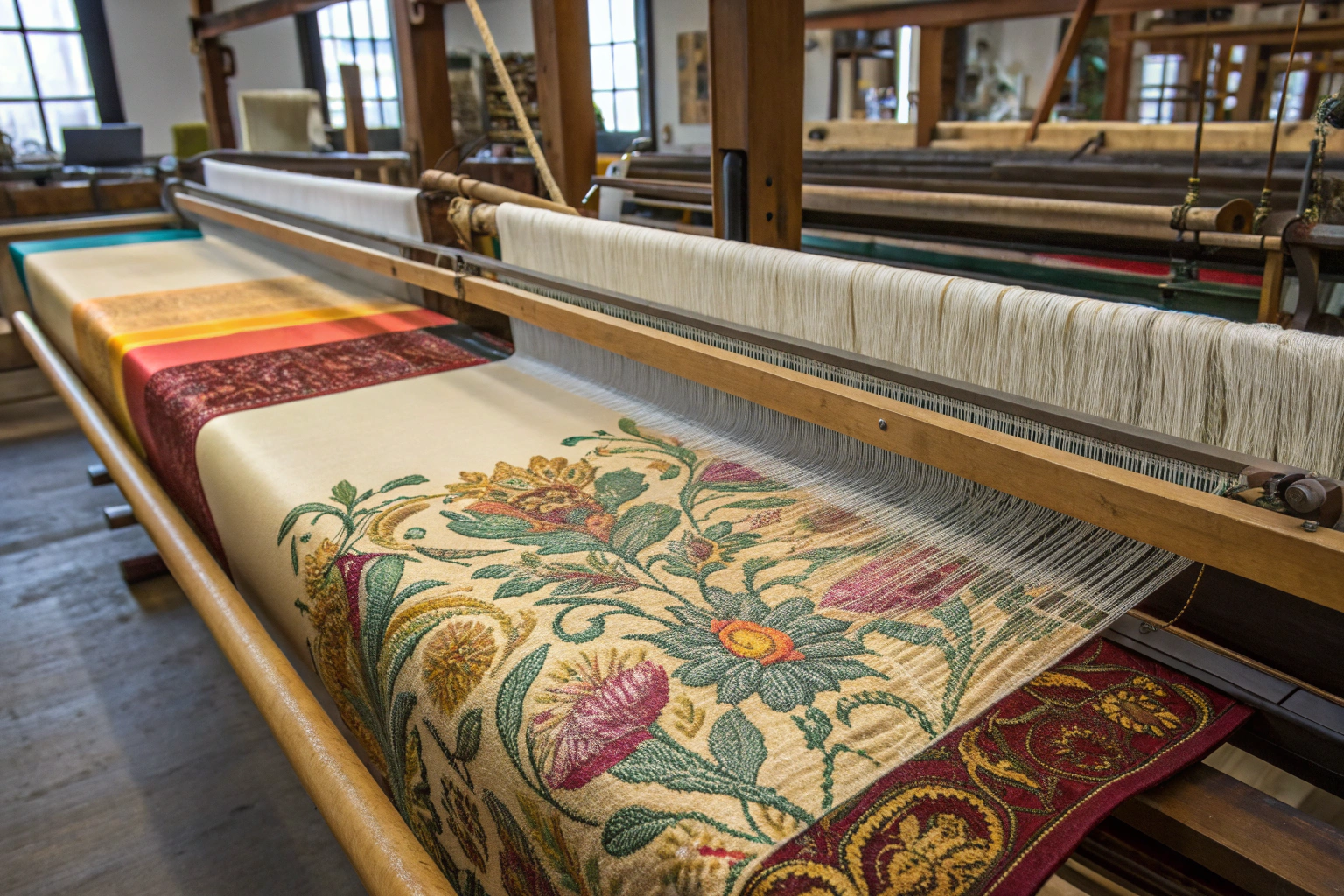When buyers, designers, or entrepreneurs encounter jacquard for the first time, they often pause in admiration. Unlike ordinary printed fabrics, whose designs rest on the surface, jacquard patterns are part of the fabric’s very DNA—woven into its structure thread by thread. This makes jacquard not only visually striking but also exceptionally durable. A jacquard sofa cover in a hotel lobby can withstand daily use for years without fading, while a jacquard gown maintains its dramatic impact even after repeated wear on stage or at events.
Jacquard fabric is a woven textile with complex motifs, created directly on a specialized jacquard loom. These motifs can be florals, paisleys, damasks, brocades, or geometric abstractions, often with raised or shimmering textures. The fabric owes its name to Joseph-Marie Jacquard, who in 1804 introduced a loom that revolutionized weaving by enabling each warp thread to be controlled individually through punched cards. His invention was so innovative that historians often describe it as a stepping stone toward modern computer programming.
Today, with computerized looms, jacquard weaving has become even more precise. Factories in textile hubs like Zhejiang, Italy, and Turkey produce millions of meters of jacquard annually, ranging from affordable polyester-blended upholstery to pure silk couture fabrics retailing at over $200 per yard. Let’s break down why jacquard is unique, how it is made, and why it continues to dominate both luxury and mainstream markets.
What Makes Jacquard Fabric Unique?
Jacquard is not defined by a single fiber but by its method of weaving. The beauty of jacquard lies in its ability to combine artistry with durability. Instead of a surface design that may wear off, jacquard patterns remain intact for the life of the fabric.
Jacquard fabrics stand out because of their durability, their three-dimensional motifs, and the fact that patterns are woven in rather than applied later.
For example, a jacquard curtain may display a subtle damask in daylight but glow with dramatic depth under evening lighting because the weave reflects light differently. Designers value this interplay of texture and shine. Meanwhile, upholsterers often choose jacquard because a sofa covered with woven motifs shows fewer signs of wear compared to one with surface prints that fade after just a few years.
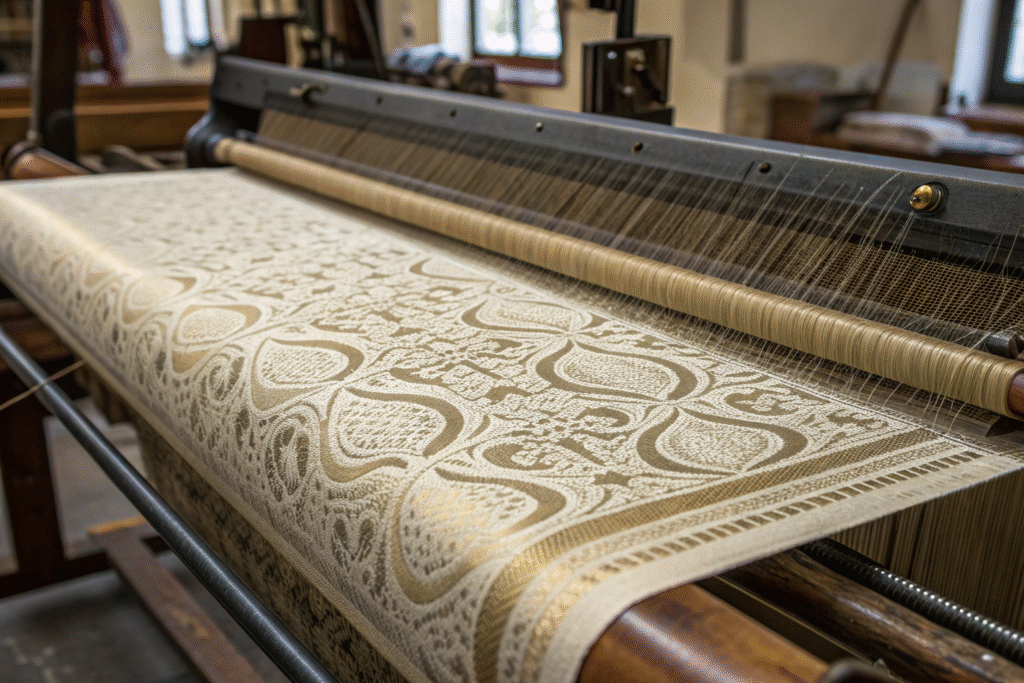
Why Is Jacquard Considered More Durable Than Printed Fabrics?
Durability is where jacquard outshines print. Printed fabrics rely on pigments or inks applied to the surface, and while modern digital printing is advanced, prints eventually fade after multiple washes. Jacquard, by contrast, integrates the design into its very weave.
According to Textile World, upholstery made from jacquard fabrics can endure 40,000 double rubs in abrasion tests—far exceeding the 15,000–20,000 double rubs typical for printed fabrics. This makes jacquard the go-to choice for hotels, theaters, and other high-use venues. In fashion, a jacquard blazer still looks vibrant after years, while a printed cotton jacket might lose its sharpness after just one season.
How Do Jacquard Patterns Enhance Fashion Design?
Jacquard brings richness without additional decoration. Designers like Dolce & Gabbana and Alexander McQueen are known for using metallic-thread jacquards that shimmer under runway lights, creating drama without relying on sequins or embroidery.
A good example is a brocade cocktail dress: the gold threads catch light from every angle, making the garment appear both sculptural and alive. According to Vogue, jacquard continues to trend in fall and winter collections because it pairs well with structured tailoring, offering designers both form and ornament in a single fabric.
How Is Jacquard Fabric Made Step by Step?
The process of creating jacquard is both technical and artistic. Each stage—from fiber choice to finishing—determines how the final fabric will feel and perform.
Jacquard weaving works by individually lifting warp threads on a loom, which allows intricate motifs to be formed directly in the weave. This method produces designs that would be impossible on ordinary looms.
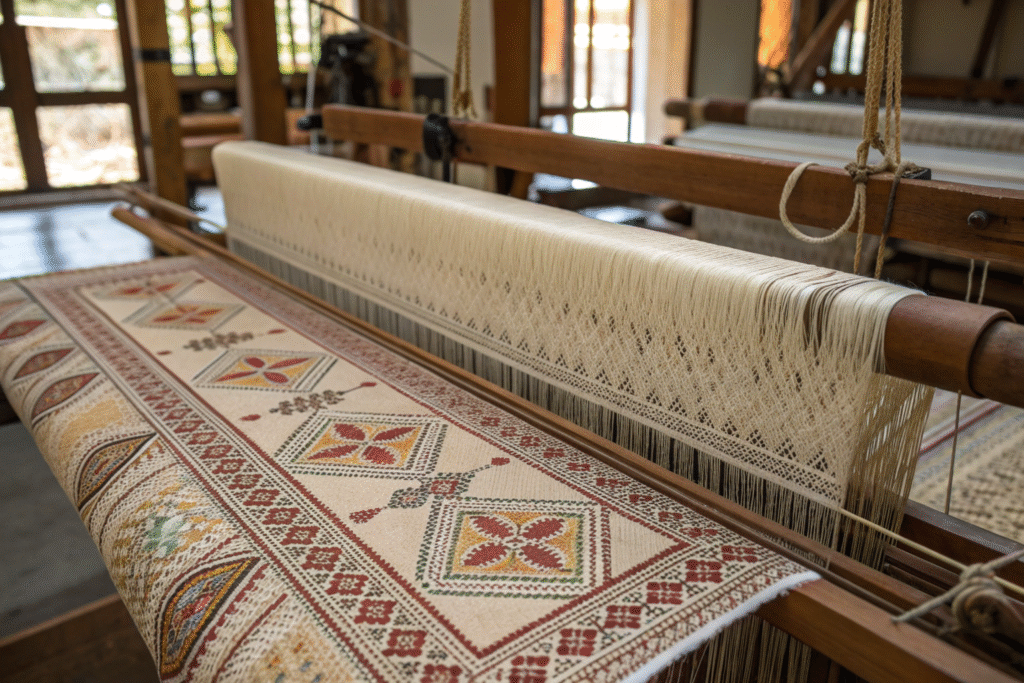
What Role Do Yarns Play in Jacquard Production?
The choice of yarn defines the final fabric:
- Silk Jacquard: High gloss, fluid drape, often used in couture gowns costing thousands of dollars.
- Cotton Jacquard: Sturdy yet breathable, common in casual jackets, dresses, and bedding.
- Polyester Jacquard: Affordable, wrinkle-resistant, and often used for upholstery in offices and hotels.
- Blends: Combining cotton with polyester or viscose produces durable yet soft fabrics ideal for fashion retail.
As The Fabric Store explains, these choices directly impact price and usability. For instance, a silk brocade worn on the red carpet offers unmatched elegance, while a polyester-cotton damask tablecloth balances affordability with stain resistance.
How Do Looms Weave Jacquard Patterns?
Originally, jacquard looms relied on punched cards—each hole representing a lifted thread. This innovation inspired early computer science. Today, modern jacquard looms are computer-controlled, enabling unmatched detail.
According to ScienceDirect, advanced looms can manage 20,000+ warp threads simultaneously, producing multi-colored, reversible, or textured motifs. This allows a fabric mill in Keqiao or Milan to deliver thousands of unique jacquard designs annually.
What Are the Main Types of Jacquard Fabric?
Jacquard is a weaving technique that includes several subcategories, each with unique properties.
The three most popular types are damask, brocade, and matelassé.
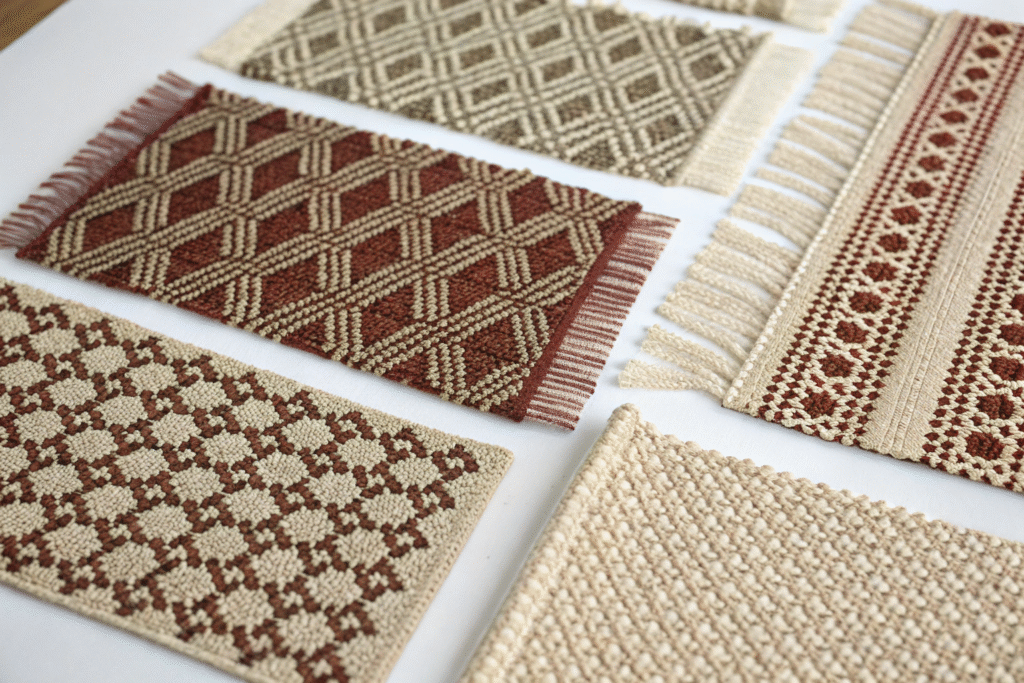
Why Is Damask Popular in Both Fashion and Home Décor?
Damask uses a single color, relying on contrast between satin and matte weaves for its reversible design. This subtle play of light makes it a timeless choice.
According to Britannica, damask fabrics originated in Damascus during the Byzantine era and were prized by European nobility. Today, they remain popular for curtains, table linens, and formal dresses. For example, a white damask tablecloth may look understated by day but shimmer elegantly under evening lighting.
How Do Brocade and Matelassé Differ From Damask?
- Brocade: Often woven with gold or silver metallic threads, creating raised, ornate designs. Used in bridal gowns, evening wear, and ceremonial robes. MasterClass notes that brocade has historically been associated with royalty.
- Matelassé: Appears quilted or padded though no padding is added. Produced by weaving two sets of warps and wefts together. Common in bedspreads, jackets, and handbags for its sculpted texture.
Both brocade and matelassé add tactile richness, making them versatile across industries.
What Is Jacquard Fabric Used For Today?
Jacquard’s applications go far beyond couture. From fashion houses to hotel lobbies, its presence is everywhere.
Jacquard is used in apparel, upholstery, drapery, accessories, and luxury interiors. Its versatility makes it one of the most commercially important woven fabrics.
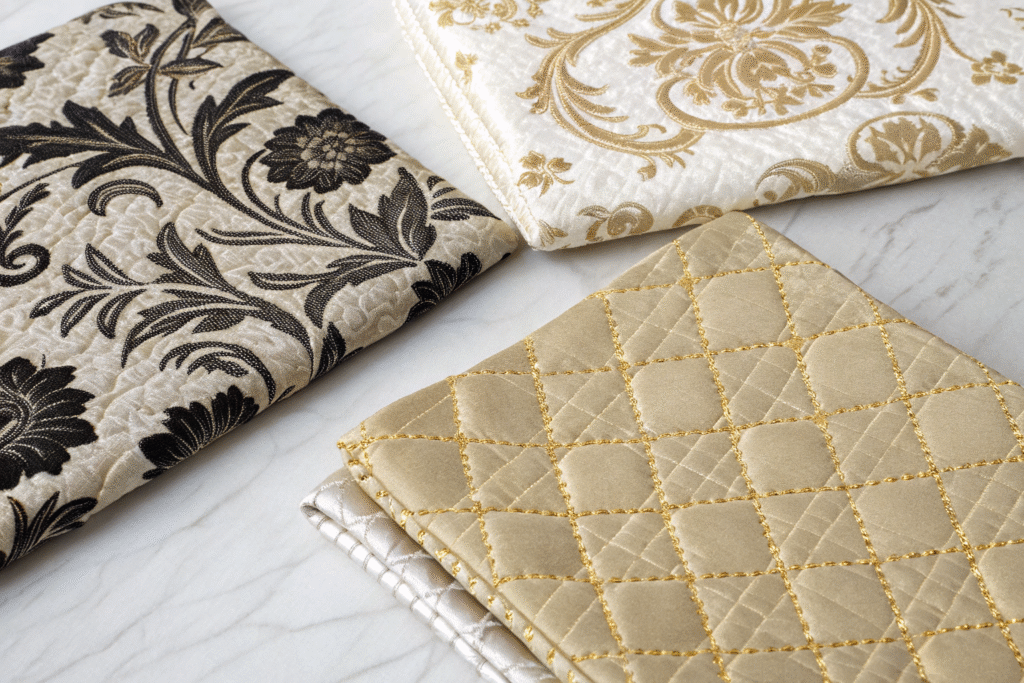
Why Is Jacquard Popular in Apparel?
Jacquard instantly elevates a garment’s perceived value. Evening gowns, cocktail dresses, and tailored jackets benefit from its structure and intricate designs. Harper’s Bazaar highlights jacquard as a runway staple, noting its ability to blend traditional artistry with modern silhouettes.
Even accessories—ties, handbags, and shoes—use jacquard because the fabric can hold shape and resist wear while offering luxury appeal.
How Does Jacquard Benefit Home and Interior Design?
Interior designers love jacquard for its combination of beauty and endurance. A jacquard sofa fabric, tested by Houzz, can last 12–15 years in high-traffic areas, compared to 7–8 years for standard prints. Hotels prefer jacquard drapery because it keeps rooms looking luxurious while resisting sun fading and frequent cleaning.
In upscale homes, jacquard bedspreads and curtains add a sense of heritage and craftsmanship that plain fabrics cannot match.
Conclusion
Jacquard fabric is a weaving method that turns yarns into patterns, blending art with technology. From its 19th-century French origins to today’s computer-controlled looms, jacquard continues to deliver luxury, resilience, and versatility. Damask brings subtle elegance, brocade adds opulence, and matelassé offers sculpted depth—each type serving fashion and interiors in unique ways.
If you are planning to source jacquard fabrics for fashion collections or interior projects, working with an experienced partner is essential. At Shanghai Fumao, we produce and export jacquard fabrics in silk, cotton, polyester, and blends, tailored to the needs of global buyers. To discuss your custom requirements or bulk orders, contact our Business Director Elaine at elaine@fumaoclothing.com. We are committed to helping you create products that showcase jacquard’s timeless artistry with modern performance.

